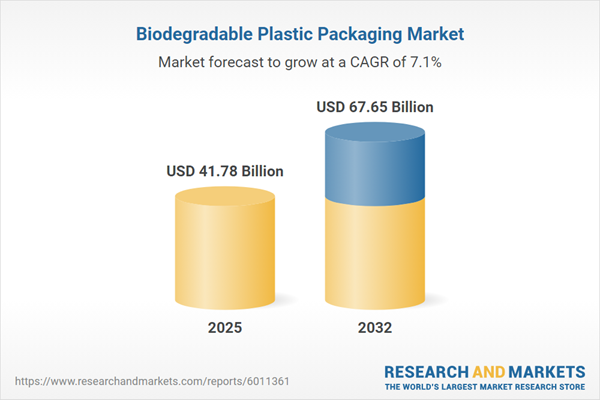Speak directly to the analyst to clarify any post sales queries you may have.
The biodegradable plastic packaging market is rapidly redefining supply chain strategies as sustainability and regulatory imperatives reshape packaging procurement worldwide. Senior decision-makers are leveraging environmentally responsible packaging to support organizational goals, mitigate risk, and future-proof operations.
Market Snapshot: Biodegradable Plastic Packaging Market Size and Growth
The biodegradable plastic packaging market is on a significant growth trajectory, with market value expected to increase from USD 39.02 billion in 2024 to USD 41.78 billion in 2025, and projected to reach USD 67.65 billion by 2032. This expansion reflects a CAGR of 7.11%, fueled by surging global demand for sustainable solutions, more stringent regulatory policies, and persistent advancements in material science. Industry leaders across sectors such as consumer goods, healthcare, and logistics recognize biodegradable solutions as essential for meeting evolving compliance requirements and supporting resilient supply chains.
Scope & Segmentation of the Biodegradable Plastic Packaging Market
- Form Types: Includes coatings and laminates, flexible films and bags, as well as rigid containers, engineered for durability and compliance in retail, manufacturing, and logistics applications.
- Coating & Laminate Technologies: Solvent-based and water-based technologies are adopted to improve processing efficiency and compatibility with various substrates, facilitating recycling for packaging manufacturers.
- Film & Bag Variants: Developed to ensure secure containment and safety, meeting both single-use and reusable packaging demands with a focus on rigorous sustainability standards.
- Rigid Container Configurations: Blow-molded and injection-molded containers offer hygiene and durability for demanding environments such as healthcare, foodservice, and industrial sectors.
- Applications: Covers agricultural goods, consumer products, food and beverage, pharmaceuticals, and medical packaging, aligning with complex supply chain and compliance challenges.
- Material Types: Cellulose acetate, PBAT, polybutylene succinate, PHA, PLA, and starch-based compounds provide procurement flexibility, ensuring alignment with regional and international regulations.
- Sales Channels: Includes direct sales, digital procurement platforms, resellers, and retail outlets, supporting industry-specific sourcing strategies across various geographies.
- Regions & Key Countries: The market records uptake across Americas, Europe, Middle East & Africa, and Asia-Pacific, with policy changes in the United States, China, India, and Japan shaping regional supply approaches and readiness.
- Major Companies Profiled: NatureWorks LLC, TotalEnergies Corbion, BASF SE, Novamont S.p.A., Danimer Scientific, Futerro SA, Mitsubishi Chemical Holdings Corporation, SK Chemicals, Biome Bioplastics Ltd., and Synbra Technology B.V. represent leading innovation and supply capability.
Key Takeaways for Senior Decision-Makers
- Procurement teams are adapting supplier evaluation models and sourcing strategies to reflect global regulatory complexity and maintain operational resilience.
- Strategic investment in biopolymer research connects material innovation with ESG and circular economy objectives, enhancing the long-term value of packaging solutions.
- Advancements in material science are expanding sector applicability, supporting performance benchmarks where hygiene, safety, and compliance play pivotal roles.
- Industry collaboration and consolidation drive transparency, streamline compliance processes, and strengthen strategic positioning with stakeholders and regulators.
- Adoption of digital tracking and verification systems strengthens compliance management and substantiates sustainability claims under diverse regulatory frameworks.
- Developing tailored risk mitigation plans for regional regulatory differences locks in supply chain agility and reduces exposure to operational disruptions.
Tariff Impact: Navigating the US Tariff Landscape for 2025
Shifts in US tariff dynamics require organizations to re-evaluate sourcing and supply structures. Increasing attention to certified feedstock, robust local partnerships, and the consideration of alternative raw materials is shaping procurement actions. Ongoing assessments of cost and compliance are essential for flexible responses to changing US policy directions in the biodegradable plastic packaging market.
Methodology & Data Sources
Analysis draws from integration of peer-reviewed research, government policy documentation, and expert interviews. All quantitative and qualitative insights underwent validation with sector specialists to deliver actionable support for executives managing procurement in this market.
Why This Report Matters
- Assists procurement executives in refining risk management and optimizing sourcing strategies tailored to the biodegradable packaging sector.
- Offers clear guidance for capital planning, compliance, and sourcing adaptation in an increasingly complex global regulatory environment.
- Supports ongoing monitoring and alignment with leading sustainability frameworks to enable consistent and transparent progress reporting in packaging operations.
Conclusion
Organizations are turning to biodegradable plastic packaging to advance sustainability goals and strengthen operational resilience. Embracing innovation and proactive market strategies remains essential for navigating evolving supply chain challenges and regulatory requirements.
Additional Product Information:
- Purchase of this report includes 1 year online access with quarterly updates.
- This report can be updated on request. Please contact our Customer Experience team using the Ask a Question widget on our website.
Table of Contents
3. Executive Summary
4. Market Overview
7. Cumulative Impact of Artificial Intelligence 2025
Companies Mentioned
The companies profiled in this Biodegradable Plastic Packaging market report include:- NatureWorks LLC
- TotalEnergies Corbion
- BASF SE
- Novamont S.p.A.
- Danimer Scientific, Inc.
- Futerro SA
- Mitsubishi Chemical Holdings Corporation
- SK Chemicals Co., Ltd.
- Biome Bioplastics Ltd.
- Synbra Technology B.V.
Table Information
| Report Attribute | Details |
|---|---|
| No. of Pages | 180 |
| Published | October 2025 |
| Forecast Period | 2025 - 2032 |
| Estimated Market Value ( USD | $ 41.78 Billion |
| Forecasted Market Value ( USD | $ 67.65 Billion |
| Compound Annual Growth Rate | 7.1% |
| Regions Covered | Global |
| No. of Companies Mentioned | 11 |









